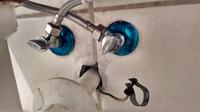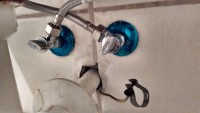hi Forumers,
I'm completely green when it comes to these things, but I'm counting on your help..
when replacing the sink faucet, I discovered that the cold water valve (in the picture on the right) does not work,
i.e. I have constant access to cold water and even though I turn off the valve, water continues to flow.
the main water valve on the cage works,
What is a cause of it? what can you do?
ps. what is the function of this yellow-green wire? ( at the bottom of the picture)
at the bottom of the picture)
I'm completely green when it comes to these things, but I'm counting on your help..
when replacing the sink faucet, I discovered that the cold water valve (in the picture on the right) does not work,
i.e. I have constant access to cold water and even though I turn off the valve, water continues to flow.
the main water valve on the cage works,
What is a cause of it? what can you do?
ps. what is the function of this yellow-green wire? (
 at the bottom of the picture)
at the bottom of the picture)



